Ekadashi fasting information importance, scientific reason, facts, benefits, divinity | Ekadashi fasting full and complete information
Namaste friends, how are you doing today? Welcome to #BhagavanBhakthi website / blog.
Bhagavan Lord Sri Krishna (Vishnu) blessings to you and your family!
In this website / blog, you will always learn about #Hinduism #Sanskrit language.
Also subscribe to my YouTube channel from this link #BhagavanBhakthi to view videos about #Hinduism #Sanskrit language.
Just before going to “Ekadashi fasting information, importance, scientific reason, facts, benefits, divinity | Ekadashi fasting full and complete information“, let us know a brief, basic and very important information.
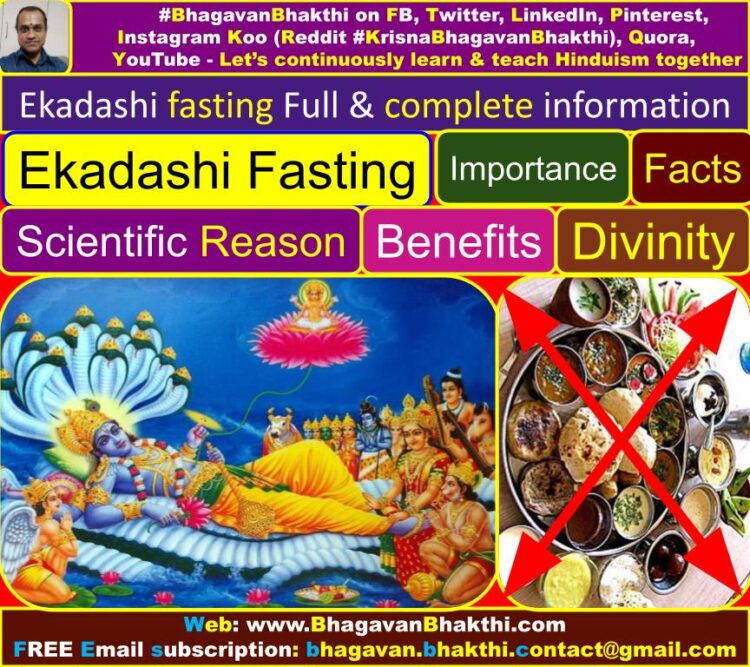
(I urge the readers to please read this post completely to gain full knowledge about Ekadashi fasting and it’s benefits and other information.)
Let us learn the full details about the Great Ekadashi fasting: Ekadashi is called as “Hari din / Day of Hari (Vishnu)”.
In Sanskrit (Hinduism) Ekadashi fasting means – Ekadashi = 11th day and Upavas (Upavasa) (Upavasam) means fasting on Ekadashi (11th ) day.
Dear friends, first let us know the meaning of “Upavas (Upavasa) (Upavasam)” (fasting) in Sanskrit (Hinduism):
“Upavas (Upavasa) (Upavasam)” in simple words means, fasting on Ekadashi (11th) day as per Hindu calendar without eating or drinking nothing.
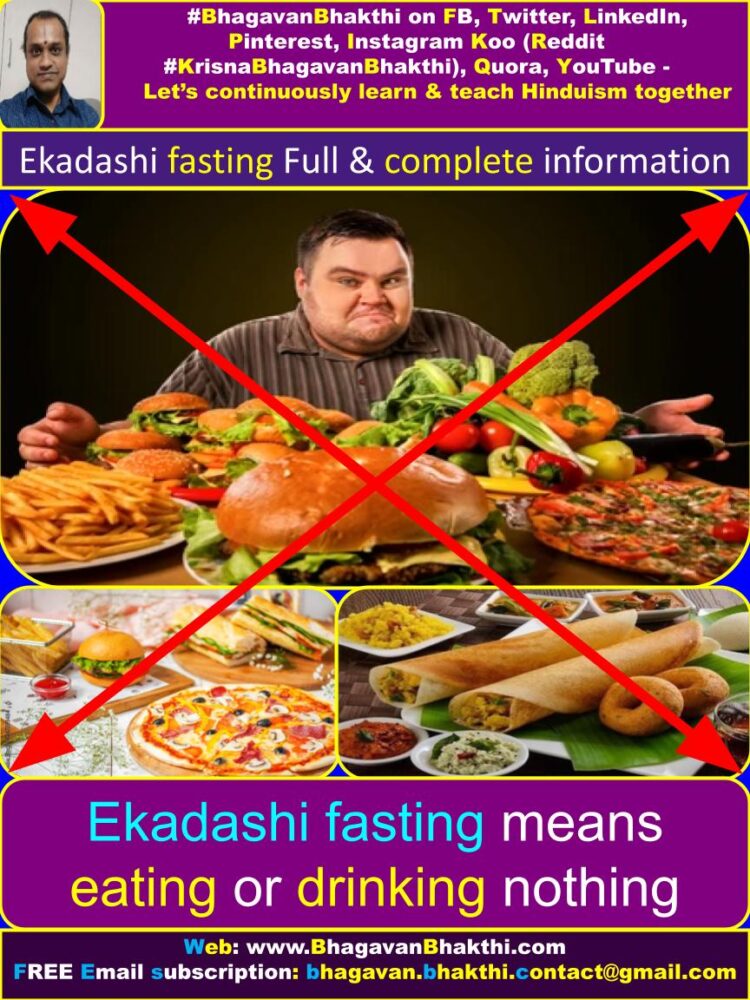
But the inner and secret meaning is: One should stay away from the banned things including food.
And also, one should always think and do only the works which will make Lord Sri Vishnu / Sri Hari / Sri Krishna / Sri Rama happy and satisfied.
The bhoga (luxury, lust etc.) things should not be done and used in any way at all, on the GREAT Ekadashi fasting (Upavas) (Upavasa) (Upavasam) day.

When does the Ekadashi fasting (Vrata) (Vrat) starts:
Ekadashi fasting (Vrata) (Vrat) begins with the sankalpam on the Dashami day (10th day).
And then fasting on the Ekadashi day (11th day) and doing Parana (Ending the fast) on Dwadashi day (12th day).
Since it is spread over three days, that is, Dashami day, Ekadashi day and Dwadashi day, it got the name Dinatraya (Here ‘dina’ means day and ‘traya’ means three).
(Dashami day means 10th day, Ekadashi day means 11th day and Dwadashi day means 12th day.)
[All these three days comes twice in each month of the Hindu Calendar (Panchanga).]
(In Sanskrit ‘day‘ is also known as tithi apart from the word dina or din or dinam.)
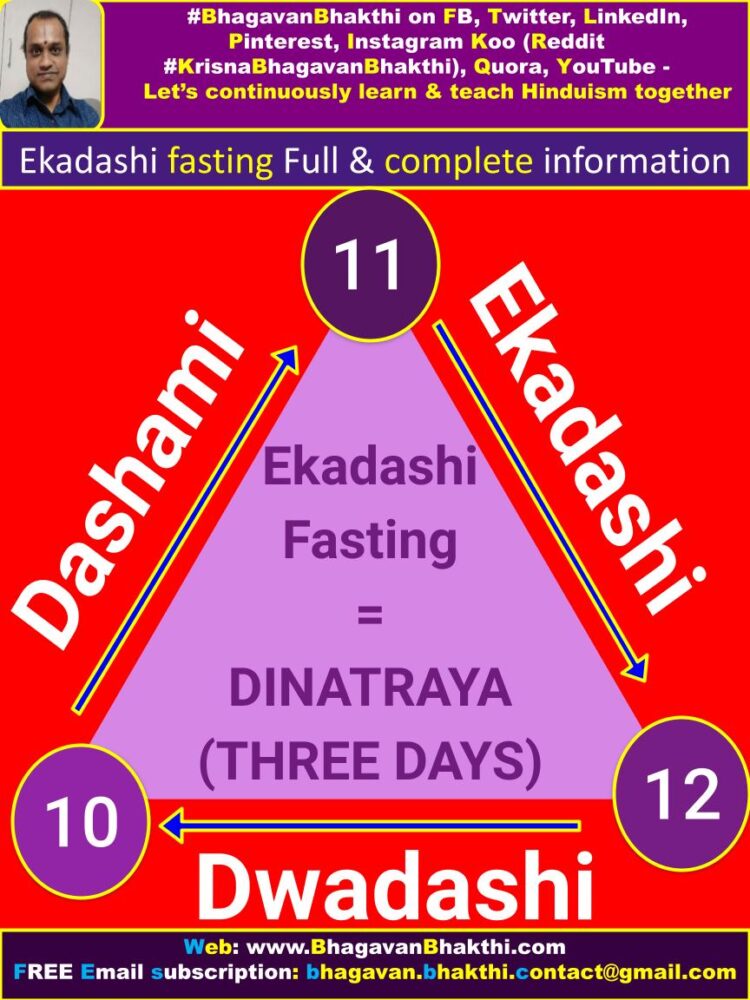
What does the Ekadashi Fasting (Vrata) (Vrat) vs Today’s Modern Scientific reason relationship:
Many must be aware that the air pressure varies on our earth starting from the ‘Amavasya’ (New Moon Day) and ends on the ‘Chaturdashi‘ (14th day).
And similarly air pressure also changes from the ‘Purnima’ (Full Moon Day) and again ends on the ‘Chaturdashi’ (14th day).
(We should note that the first fifteen days of the Hindu Calendar month is called as ‘Shukla Paksha’.)
(And the second fifteen days of the Hindu Calendar month is as called ‘Krishna Paksha’).
[Shukla Paksha 15 days + Krishna Paksha 15 days = 30 days as per Hindu Calendar (Panchanga).]
Shukla Paksha 15 days as given here : Padya (Day 1), Dvitiya (Day 2), Tritiya (Day 3), Chaturthi (Day 4), Panchami (Day 5), Shashti (Day 6), Saptami (Day 7),
Ashtami (Day 8), Navami (Day 9), Dashami (Day 10), Ekadashi (Day 11), Dwadashi (Day 12), Trayodashi (Day 13), Chaturdashi (Day 14) and Purnima (Full Moon Day).
(In Sanskrit Shukla Paksha means from darkness towards brightness. Shukla is also a name of Lord Sri Vishnu.)

Krishna Paksha 15 days as given here : Padya (Day 1), Dvitiya (Day 2), Tritiya (Day 3), Chaturthi (Day 4), Panchami (Day 5), Shashti (Day 6), Saptami (Day 7),
Ashtami (Day 8), Navami (Day 9), Dashami (Day 10), Ekadashi (Day 11), Dwadashi (Day 12), Trayodashi (Day 13), Chaturdashi (Day 14) and Amavasya (New Moon Day).
(In Sanskrit Krishna Paksha means from brightness towards darkness. Krishna is also a name of Lord Sri Vishnu.)

The pressure on the earth on the ‘Amavasya’ (New Moon Day) and ‘Purnima’ (Full Moon Day) is highest (one can understand this by seeing the ocean).
And after both ‘Amavasya’ or ‘Purnima’ gradually the pressure on the earth varies day by day.
This means on ‘Amavasya’ or ‘Purnima’ the pressure is highest and on the second day, that is, ‘Pratipada’ (1st day) the pressure decreases little bit, similarly on the ‘Dvitiya’ (2nd day) the pressure decreases more.
Similarly on other days like ‘Tritiya’ (3rd day), ‘Chaturthi’ (4th day), ‘Panchami’ (5th day), ‘Shasti’ (6th day),
‘Saptami’ (7th day), ‘Ashtami’ (8th day), ‘Navami’ (9th day), ‘Dashami’ (10th day),
‘Ekadashi’ (11th day) (on this day the pressure is most least compared to other days), ‘Dwadashi’ (12th day),
‘Trayodashi’ (13th day) and ‘Chaturdashi’ (14th day) also the pressure keeps on varies.

It is same in the human body also. The pressure keeps on varying on all these days.
Thus our ancestors (starting from the Lord Sri Vishnu) had done this plan, that is, to minimize the pressure on our body (To avoid over eating).
One should have a day out of these fifteen days, that the pressure inside our body could be stabilized by not at all consuming anything (Not even a drop of water).
[Ekadashi day (11th day) – this is the day when the pressure in our body is least and if someone does the fasting (Upavas) (Upavasa) (Upavasam) that would definitely be very useful and beneficial to that person.]
That is, if body doesn’t has much work to do, then it keeps itself calm and thus pressure & other things can be managed by our body automatically (We can be in peace and happy).

Thus a day of Ekadashi (11th day) was considered, and that day was comtemplated as an auspicious day (Both materially and spiritually).
More over, our pitrus (ancestors) advised not to eat or drink anything on that particular day, so that one can manage the pressure and other things very easily inside and outside of our body.
[Now, my dear friends think, who are forward in Science and Technology, that is, Indians (Hindus) or other countries?]
If one consumes limited and satvika (A kind of divine and vegetarian food) food means, one will be heal and healthy.
Even today’s Science says the same thing. That’s why our Hindu Shastras (texts) are so great and versatile.

But one may get the question, “why only on Ekadashi day one should do fasting (Upavas) (Upavasa) (Upavasam)?
Yes, we have answer for this also as given below!
As said above, the pressure on earth and also the pressure on our body would be least on Ekadashi day (11th day).
Thus it is easy for us to manage our body without food and water on this particular day of Ekadashi day (11th day).
(This is very simple to understand. Many of you work 5 – 6 days a week. Later you rest 1 or 2 days a week.)
(If you need rest for 1 or 2 days a week, then your body also has all the freedom to take rest for at least 1 day in 15 days.)

Yes, we have answer to this also as given below:
Our body doesn’t need anything to sustain our body on this Ekadashi day (11th day), because of the low pressure inside our body and outside our body (earth / space).
One can easily manage the stress on our body on this Ekadashi day (11th day).
One can easily calm the body when there is no pressure or stress on the body on this Ekadashi day (11th day).
What more we need to keep our body heal and healthy and off course fit.
That’s why Bharatiya Sampradaya (Indian tradition) is the most PERFECT, FINEST and FORWARD in everything since unknown time frame.
Everybody knows that over eating is the main cause of ill health and diseases are spreading in today’s so called knowledgeable and / or educated world.

Why nearly 50% of the world’ population is having health problems?
Why big food companies are making huge amount of money?
Why today’s India is getting over weight?
The more one eats, the more diseases one has. The less or more limited amount of food one eats, the more heal and healthy we are.
The same is said by our GREAT Indian pitrus (ancestors).
Indian pitrus (ancestors) were knowing everything about the earth and our body.
What to eat? What not to eat? How much to eat? How to eat? Where to eat? When food should be served?
When food not be served? etc. etc. etc. everything was known by our GREAT INDIAN PITRUS (ancestors).
Again think my dear friends, who is forward in thinking (intellectual) Indians or other countries?

Now, let us know more about the GREAT Ekadashi according to our Hindu Shastras (texts).
What Mahabharata (Shanti Parva) says about Ekadashi fasting
“अहिंसा सत्यवचनं दानमिन्द्रियनिग्रह | येतेभ्यो ही महाराज तपो नानशनात् परम्” |
“ಅಹಿಂಸಾ ಸತ್ಯವಚನಂ ದಾನಮಿಂದ್ರಿಯನಿಗ್ರಹ | ಯೇತೇಭ್ಯೋ ಹೀ ಮಹಾರಾಜ ತಪೋ ನಾನಶನಾತ್ ಪರಮ್” |
“ahimsā satyavacanaṁ dānamindriyanigraha | yētēbhyō hī mahārāja tapō nānaśanāt param” |
Meaning of the above shloka : Compared to non-violence, always speaking the truth, control of the sensory organs (indriyas),
doing fasting (Upavasam) on Hari Dina (Ekadashi) is highly valued (means there is no greater tapas / penance then doing Upavasam / fasting on Ekadashi).
Doing Upavasam / fasting will help us to restore our Indriyas (sensory organs).

With this we can do the dharmacharana (rituals pertaining to Sanatana Dharma) and thus we can get the higher planets like Svarga and finally to Vaikuntha.
This means by doing the Ekadashi Upavasam (fasting), we can get both materialistic and virtuous things (Related to Lord Sri Vishnu).
Different types of fasting (Upavas) (Upavasa) (Upavasam) is as given below:
‘Ekabhukta (एकभुत्क) (ēkabhukta)‘ – Here eka means one, bhukta means leaving – this means leaving one time’s food.
‘Dravaahara (द्रवाहार) (dravāhāra)‘ – Here drava means liquid and ahaara means food – this means having only liquid food.
‘Phalahara (फलाहार) (phalāhāra)‘ – Here phala means fruits and ahaara means food – this means having only fruits.
‘Vihitahara (विहिताहार) (vihitāhāra)‘ – Here vihita means allowed and ahaara means food – this means having only allowed food.
‘Mitahara (मिताहार) (mitāhāra)‘ – Here mita means limited and ahaara means food – this means having only limited food.
‘Nirahara (निराहार) (nirāhāra)‘ – Here nira means not at all having and ahaara means food – this means having nothing – including water.
The other name of ‘nirāhāra‘ is ‘nirjala‘, that is, this means doing fasting (Upavasam) even by not consuming a drop of water.
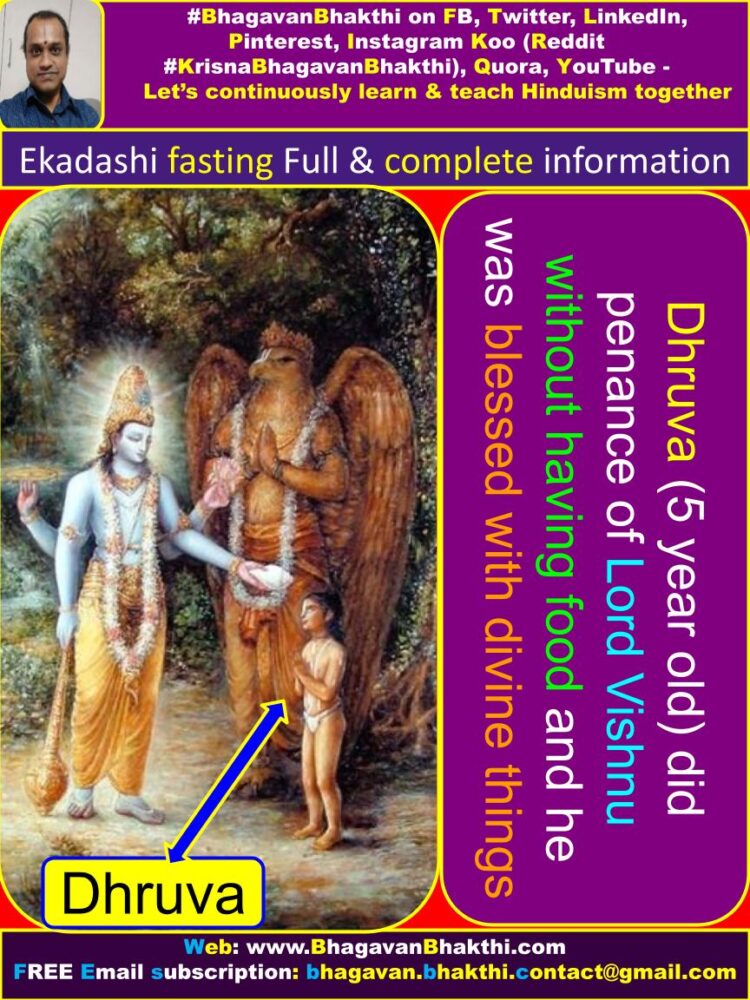
Among the above said fasting (Upavasams), doing the ‘nirāhāra or ‘nirjala‘ fasting (Upavasam) is the best and this will ultimately yield us the best fruits to the doer.
(Just for example – If a student studies through out the year in the right way, then that student will get very very good marks)
(That is he / she may get 100 out of 100. Similarly someone studies only half means that student will get average marks)
(And also a student who studies nothing or very little bit means that student get just pass marks or he / she may get failed in the examination also.)
[Remember if we need to be more closer to Lord Sri Vishnu means, we need to perform our Dharma (Duties) properly, rightly, with full devotion.]
(And also with full respect, then only we will get more and more marks, otherwise we will get marks as per our qualification and capacity. Everything is left to us.)

We may go to Kashi or to Gaya or we may take bath in the Great Ganges river or in the Great Narmada river or in the Great Godavari river.
Or we may even visit the Great place like Kurukshetra or any other place, but it won’t yield us as much the great fruits as when we do the fasting (Upavasam) on an Ekadashi day.
This is the Greatness of the Great and Divine Ekadashi day.
This means, the fruits what we get by visiting all these places, can be easily obtained by just doing the Ekadashi fasting (Upavasam)
[Please remember here, Hindu Shastras (texts) are talking about the ‘Nirjala Ekadashi Upavasam‘, that is, doing Ekadashi fasting by not having even a drop of water.]

Among all the yagnas, doing Ekadashi fasting (Upavasam) is best and greatest.
We may do thousands of ‘Ashvamedha yagnas’, we may do ten thousand ‘Vajapayee yagnas’, but this is not even equal to 1/16th of the total of what we do of the Ekadashi fasting (Upavasam).
Among all the ‘Parva Kalas’ (auspicious times) doing Ekadashi fasting (Upavasam) is greatest and best.
We may do great works during the thousands of ‘Grahanas’ (eclipses), we may do great works during the ‘Vyateepaatas‘,
we may do great works during the lakhs of ‘Amavasyas‘ (Full moon days), but this is not equal to 1/16th of what we do on ‘Dwadashi‘ (12th day), that is, a day after Ekadashi day.
Here ‘Dwadashi‘ means, this is also part of the ‘Ekadashi‘ – the three days such as ‘Dashami‘, ‘Ekadshi’ and ‘Dwadashi‘ are considered as ‘Ekadashi Vrata (Vrat)‘ day itself.
[Please see above about Dinatraya = Dina + Traya = Day + three = Three days of Ekadashi Vrata (Vrat).]
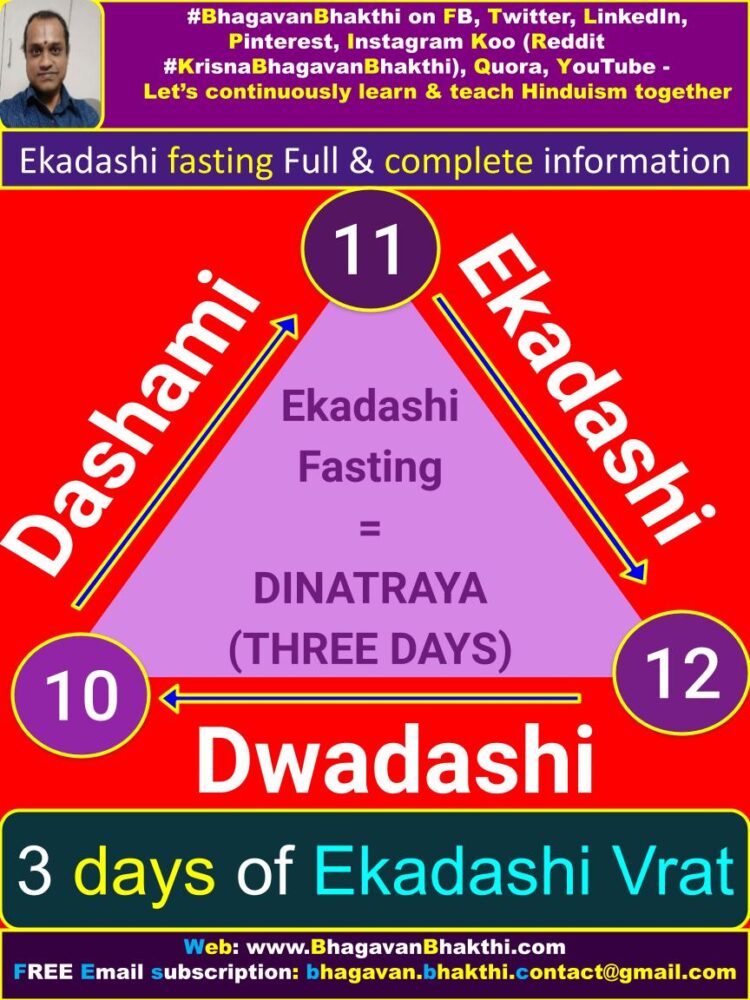
This is because, as these including three days is known ‘Ekadashi Upavasam vrata (vrat)‘, that is, Dashami day (10th day), Ekadashi day (11th day) and Dwadashi day (12th day).
Just by celebrating the ‘Ekadashi Vrata (vrat)‘ (Fasiting on Ekadashi day), we will easily be get freed from our earlier lives’ bad karmas.
When we do the Ekadashi fasting (Upavasam), we may get little hardships of been empty stomach.
But doing the Ekadashi fasting (Upavasam), we will definitely won’t get any pain of the body both physically and mentally.
But rather, the Ekadashi fasting (Upavasam) will help us to burn all our earlier bad Karmas.
This is the great message which we will get by doing the Great and Divine ‘Ekadashi Fasting (Upavasam)‘.
We can easily believe that doing the Ekadashi Vrata (Vrat) (Fasting) in the right way, will ultimately benefit in getting cured of unlimited diseases including heart ailments, digestive problems, lung ailments, etc..
(This has even been proved by the modern doctors who are aware of both modern science and about Ekadashi fasting).

Modern scientific experiments have proved that blood clots and fat accumulation can be easily cured by doing the GREAT Ekadashi Vrata.
As soon as a person celebrates the GREAT Ekadashi Vrata he / she will be freed of all the previous bad Karmas.
[Note : Ekadashi Vrata (vrat) means, doing fasting on Ekadashi day and also following other rituals pertaining to these days, that is –
[Dashami day (10th day), Ekadashi day (11th day) and Dwadashi day (12 day.]
Purification of all senses will happen by doing the Ekadashi Fasting Vrata (Vrat) (Upavasam):
Ekadashi Indriyas (Eleven sensory organs)
This means the bad Karmas which we had done through the inner mind, that is-
Pancha (five) Jnanendriyas – Ghrana (Nose), Chaksu (eyes), Rasana (tongue), Tvak (skin) and Srotra (ears).
Pancha (five) Karmendriyas – Vaak (speech), Paani (hands), Paada (feet), Paayu (Excretory organ) and Upastha (Organ of reproduction).
Manas (Mind) (The 11th Indriya) will be freed as soon as we start doing the Ekadashi Fasting (Vrata) (Vrat).

यम भाध (Yama Bhada) (yama bhādha) – Problems pertaining to death,
शनि काट (Shani kaata) (śani kāṭa) – Problems pertaining to Lord Sri Shani Deva, will be solved if one does the Ekadashi Vrata (Vrat) (fasting).
The ‘samudra manthana’ (ocean churning) took place on the Ekadashi day itself.
And on the ‘Dwadashi’ day, Goddess Sri Mahalakshmi Devi got emerged from the ocean.
This is very clearly said in the ‘Padma Purana’.
Ekadashi Fasting as said in the Varaha Purana
As per Varaha Purana for the pregnant ladies, during post pregnancy, the very elderly, the unhealthy people can have some amount of food (but limited).
Here some amount of food doesn’t mean that one can have lots of water or milk or fruits or chapatis or idlis or dosas etc.
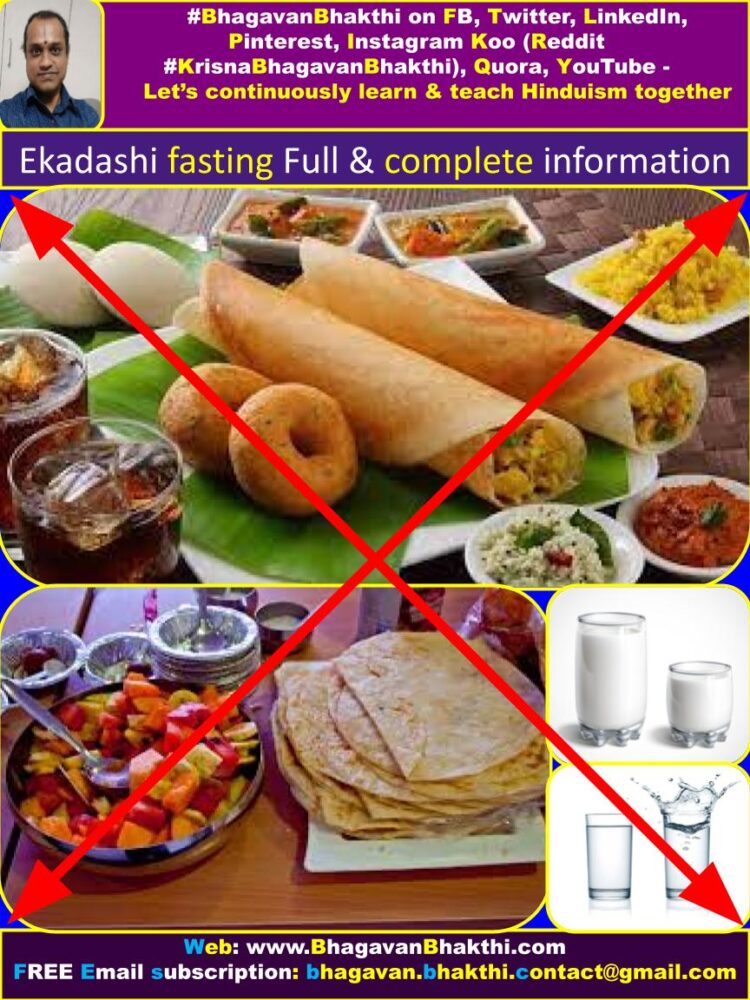
But can have some amount of water, milk and fruits (but very very limited).
Salt, food containing urad dal (Split black lentils or Black gram dal) should not at all be eaten as food on the Ekadashi day.
(This is for the above said pregnant, post pregnancy, elderly and unhealthy people only and not for the common man.)
(The common man should not at all even think of eating or even smelling any type of food. Remember the ‘nirjala upavasam‘ as said above).
Cooked grains and food containing salt should not at all be eaten on the Ekadashi day as it is a form of food item.
Such food should be eaten which should be equal to or less then only one-fourth (1/4th) amount of the food we eat on the other days.
(Again remember this is for the pregnant, very elderly and unhealthy people only).
Even someone who tell or forces others to have food on the Ekadashi day will have to face the Naraka Bhada (hellish problems).

Having food on the Ekadashi day is more sinful than the Brahma Hatya Dosha (Sin of killing a Brahamana / Brahmin).
Ekadashi fasting is compulsory, even in the case of ‘sutaka‘ (सूतक) (sūtaka) (sutak) (if someone has died in the family) and during the ‘rajaswala‘ time (women’s monthly period / menstruation period).
The wife or the servant(s) who helps in completing the ‘Parana‘ (पारण) (pāraṇa) of the husband or owner on the ‘Dwadashi‘ day, will not get the dosha (will not be called as faulty).
(Parana is done on the Dwadashi day (12th day) – Parana means doing pooja of Lord Sri Vishnu and later have naivedya water and / or food.)
These people (wife or servants) can have the food after doing the ‘Tirtha Parana‘ (तीर्थ पारण) (tīrtha pāraṇa) along with husband or the owner on the Dwadashi day.
[Tirtha means having tirtha (divine water) after the pooja of Lord Sri Vishnu on Dwadashi day.]
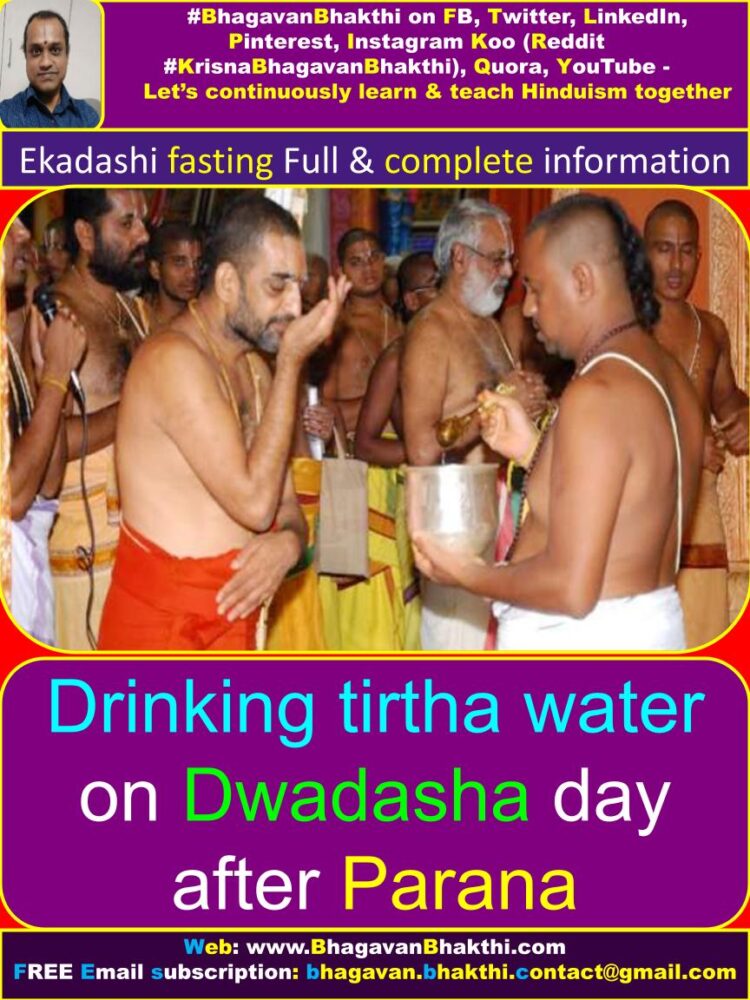
The sins obtained while having food on the Ekadashi (fasting) day is as given below:
Few ‘Paapa Karmas‘ (पाप कर्म) (pāpa karma) (Bad Karmas) can be cleared by doing darshan of Lord Sri Surya Deva (Sun).
Whereas if someone eats the food on the GREAT Ekadashi day, then it is considered as huge ‘Paapa Karma‘ (पाप कर्म) (pāpa karma) (Bad Karmas).
On earth there are several ‘Paapa Karma‘ (पाप कर्म) (pāpa karma) (Bad Karmas) including the Brahma Hatya Dosha (Sin of killing a Brahmana / Brahmin).
We should note that all such ‘Paapa Karma‘ (पाप कर्म) (pāpa karma) (Bad Karmas) would be staying in the food on the Ekadashi day.
On the Ekadashi day all the food items would have become full of ‘dosha‘ (दोष) (dōṣa) (sins).
Thus on the Ekadashi day the food should not be eaten at all, should not be served at all and also even smelling the food is also considered to be a ‘Paapa Karma‘ (पाप कर्म) (pāpa karma) (Bad Karmas).

One may be a Brahmachari (Unmarried) or a Grihastha (Married) or a Vaanaprastha or a Sanyasi (Saint) or one may be even a Brahamana or a Kshatriya or a Vaishya or a Shudra,
or may be even a woman with or without a husband or a married woman or may be anyone on this earth, the Ekadashi Fasting is a must on the Ekadashi Day.
If a person is over eight years old and who is less then eighty years, that person has to celebrate the Ekadashi fasting (Vrata) (Vrat)
(Even a woman during pregnancy or post pregnancy or an unhealthy person should take only very very limited food as mentioned earlier).
One should even not think that since I am over eighty years, I can eat whatever I want and / or how much ever I need I will eat. No, that can’t happen on the Ekadashi day.

The unhealthy people can have these below food on the Ekadashi day:
Dates, jack fruit, mango, banana, grape, fruits, Milk, yogurt, ghee, non-tuber potatoes, grains cooked with only water.
These above mentioned food item(s) can be eaten for only a quarter of what the stomach needs.
(Please remember the said food items may be taken for about quarter of the amount one usually takes on other days).
Food which shouldn’t be eaten on the Ekadashi day by any common person:
Any food cooked with and / or without grain(s) using the combination of water and / or fire, and any flour item made using the salt mixture.

[Remember the above said ‘nirjala’ Upavasam. If we need full marks, then we need to do the ‘nirjala’ fasting (Upavasam).]
Water, fire and salinity are the result of these three combinations – these are all considered as food items.
Thus upma, dosa, chapati etc. etc. etc. are all are considered as food items.
Even very very limited urad dal (Split black lentils and Black gram dal), salt, non-veg all are made with salt and fire, they shouldn’t be eaten on the Ekadashi day.
Everybody has to celebrate the Ekadashi Vrata in the same manner.
There is no difference in the way of the celebration of Ekadashi day including a Brahmana, Kshatriya, Vaishya, Shudra, Chandala, woman, child (above 8 years), etc.
(For Lord Sri Vishnu all are same, expect the quality of the knowledge.)

About vidvaikadashi (विद्वैकादशि) (vidvaikādaśi)
Here ‘vidvaikaadashi‘ (विद्वैकादशि) (vidvaikādaśi) means, Ekadashi that falls on two continuous days.
On the ‘vidvaikaadashi‘ (विद्वैकादशि) (vidvaikādaśi), that is, two days of Ekadashi, one should never ever do the fasting (Upavasam) on the first day (First day of the two days of Ekadashi).
Gandhari (Dhritarashtra wife) had celebrated the Ekadashi fasting (Vrata) (Vrat) on the ‘vidvaikaadashi‘ (विद्वैकादशि) (vidvaikādaśi), this means an Ekadashi day which would also have the ‘Dashami‘ tithi in it.
For this reason, Gandhari (Dhritarashtra wife) had lost all her 100 sons (Kauravas, including Duryodhana, Dushasana, etc.)
When there is a dispute (Dispute of days of Ekadashi), it is advisable to fast on the ‘Dwadashi‘ day.
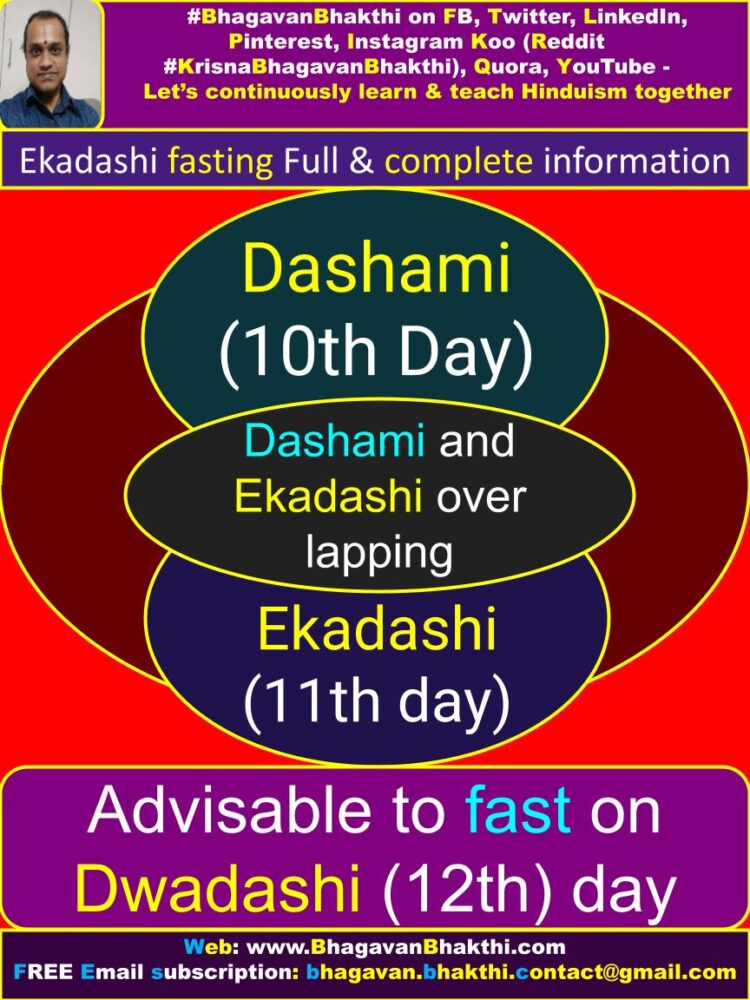
This means on the ‘Atirikta‘ (अतिरिक्त) (atirikta) Dwadashi day, the fasting (Upavasam) has to be celebrated.
(Please note that, this is only during the ‘vidvaikaadashi‘ (विद्वैकादशि) (vidvaikādaśi) time – one need to consult the correct Vaishnava Brahmana about this for more information).
Fasting (Upavasam) on the ‘Shravana Ekadashi’ day:
Here Shravana Ekadashi means, if on Dwadashi day Shravana nakshatra is present, then two days of continuous fasting has to be done, that is, fasting on both Ekadashi day and also on Dwadashi day.
Somebody who doesn’t celebrate the Ekadashi Fasting (Upavasam) Vrata (Vrat) on the Shravana nakshatra, that person will accumulate huge amount of the bad Karmas and he / she will become ‘mandha buddhi’ (dull minded).
The Shravana Dwadashi may fall on the ‘Bhadrapada’ (भाद्रपद) (bhādrapada), ‘Magha’ (माघ) (māgha) and ‘Phalguna’ (फाल्गुन) (phālguṇa) months only.
(Here Shravana Dwadashi means, Dwadashi day with Shravana nakshatra.)
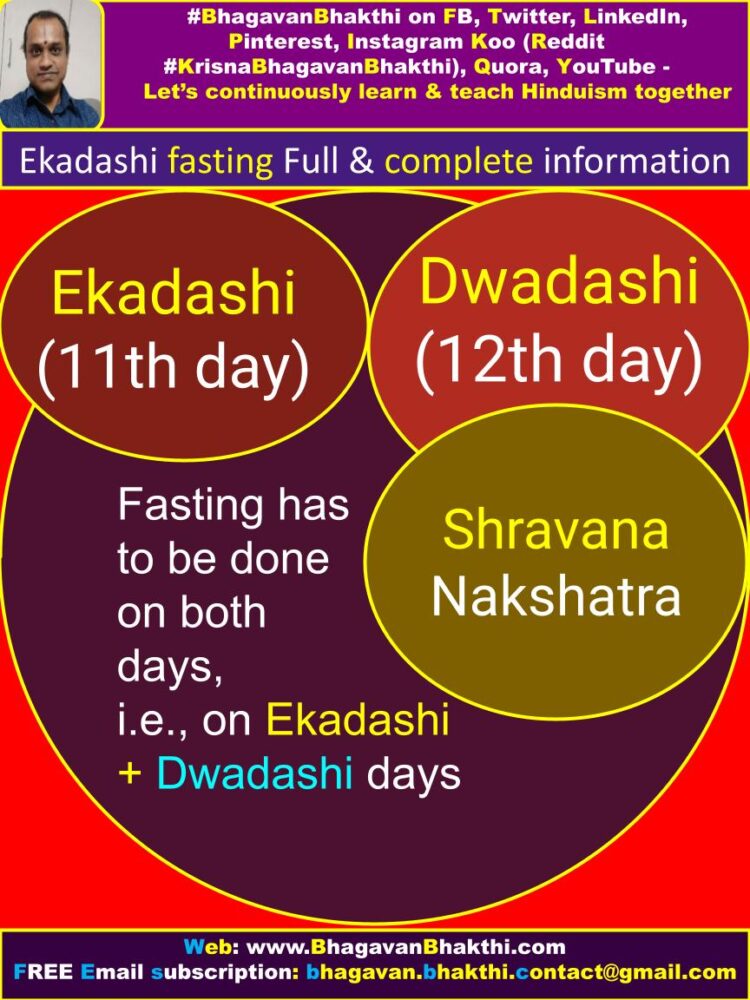
Having food in others’ house on Dashami and Dwadashi days
On the Dashami and Dwadashi days, one should never ever have food in somebody else’s house (or outside) and it would also accumulate lots of bad Karmas.
Here one may get a question that, during the Shravana Dwadashi period one has to do two days of continuous fasting (Upavasam)?
Dwadashi Vrata (Vrat) is a Vishnu Vrata (Vrat).
That day (Dwadashi day) if someone does the Parana and if completes the Upavasam Vrata (Vrat), wouldn’t that be considered as the completion of the Vrata (Vrat)?
Since Lord Sri Vishnu is the Devata for the Dwadashi day, similarly for the Shravana nakshatra also Lord Sri Vishnu himself is the Devata.
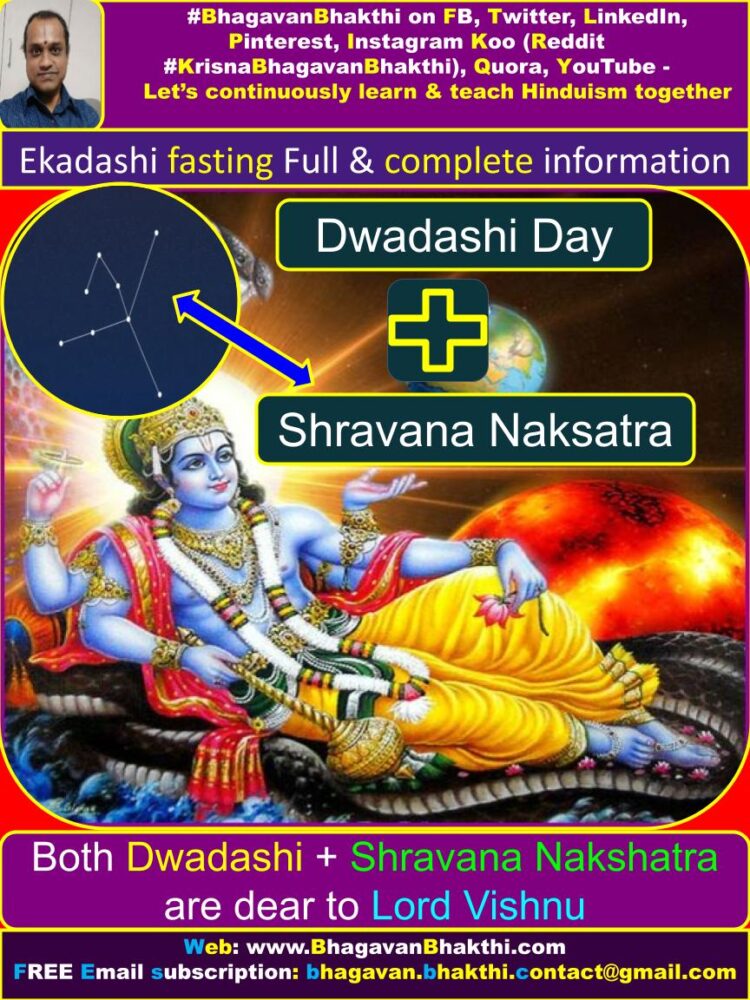
Thus if one does the fasting (Upavasam) on the Dwadashi (With Shravana Nakshatra only) along with the Ekadashi day (means total of two continuous days), that Dwadashi’s Parana Vrata (Vrat) is not broken.
Please remember that, Parana shouldn’t be done on this Dwadashi day (With Shravana nakshatra), instead on the Trayodashi day (13th day) Parana has to be done.
(Please consult a correct Vaishnava Brahmana to know more about Shravana Dwadashi Fasting.)
Works to be done and not to be done on Ekadashi fasting day
The meaning of “Upavasam” (fasting) is that, one should stay away from the banned things.
And also should always think and only do the works which will make Lord Sri Vishnu happy.
No bhoga (luxury, lust etc.) things should not be done on the fasting (Upavasam) day.
Only things related to Lord Sri Vishnu (Or any avatar of Lord Sri Vishnu) should be done like as given below:
Reading and hearing about the Sanatana Dharma granthas (texts) (especially related to Lord Sri Vishnu), listening the pastimes of Lord Sri Vishnu (Krishna) (Rama) (Any avatar of Lord Sri Vishnu) and his different avatars etc.
E.g., Srimad Bhagavatam, Mahabharata, Ramayana, Padma Purana, Varaha Purana, Narada Purana, etc.
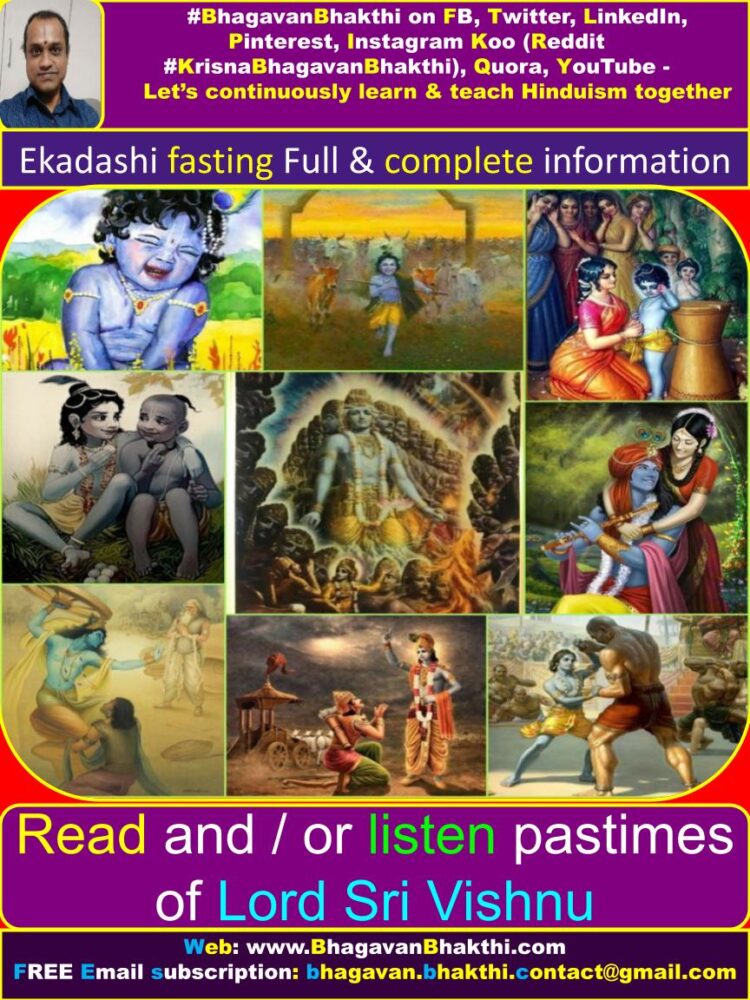
In all these three days, that is, Dashami day, Ekadashi day and Dwadashi day, one should avoid over eating, applying oil on any part of the body, sleeping during day time, drinking lots of water etc.
On the Ekadashi day, one should not have the tirtha more then once.
(Please remember only tirtha can be taken that too only once and that too very very limited).
On all these three days, that is, on Dashami day, Ekadashi day and Dwadashi day, violence, enmity, talking untruth, eating taambula (beetle leaves), sleeping during day time, sambhoga (intercourse), gambling, etc. are all completely forbidden.
Brushing on Ekadashi Fasting day
If one does the gargling Dwadashi times (12 times) it is considered as brushing the teeth on the Ekadashi day.
(On Ekadashi fasting day, one should even not brush his / her teeth, but instead should gargle with normal water for 12 times.)

On the three days, that is, on Dashami, Ekadashi and Dwadashi days, one should not eat food too much –
That is, on Dashami day one should eat only once, on Ekadashi day complete fasting and also on the Dwadashi day only once food has to be taken.
If someone dies on the Ekadashi day, the Shraddha (Pitru Shraddha) of that person should be done on the Dwadashi day.
(Please consult a correct Vaishnava Brahmana to know more information about this.)
During the Dwadashi day, if one can’t do the Parana because of the some unexpected reasons, then that person can have some water to complete the Ekadashi Fasting Vrata (Vrat).
[Please remember the great King Ambarisha Maharaja’s story – When Durvasa Muni comes to meet Ambarisha Maharaja unexpectedly on Dwadashi day,]
[at the time King Ambarisha Maharaja consumes little bit of water to complete Ekadashi Fasting Vrata (Vrat) as per the instructions of Maharishi Narada.]
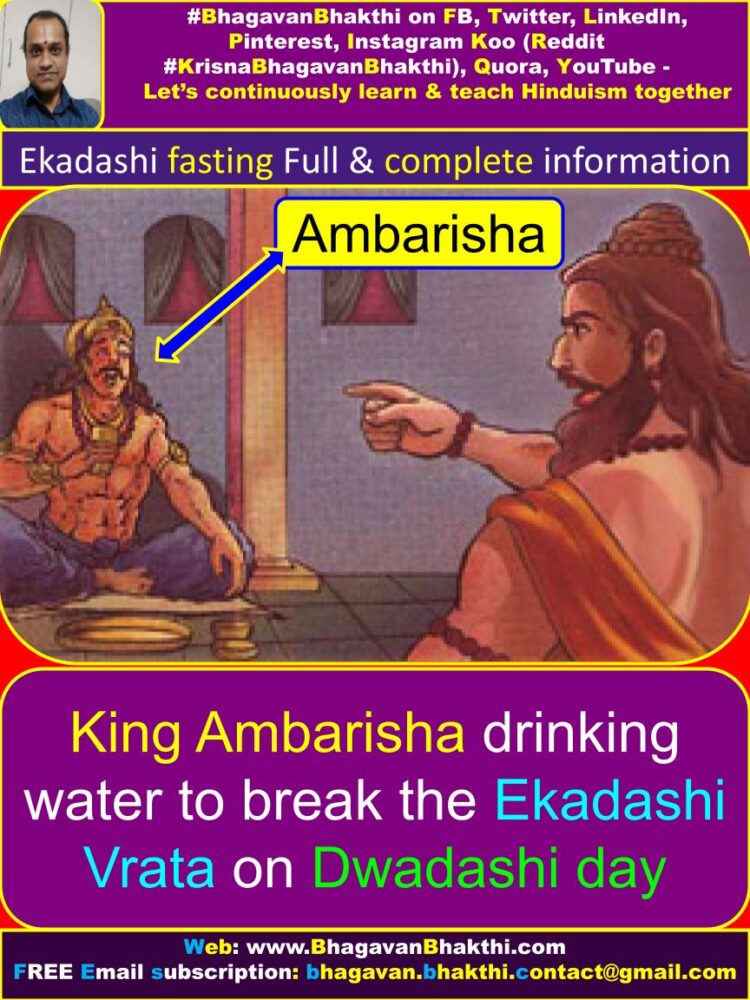
Different Ekadashi names are as given below:
Ekadashi names during the Shukla Paksha as per Hindu Month Calendar (Panchanga) are as given below:
Chaitra Month : Kaamadaa Ekadashi (कामदा एकादशी) (kāmadā ēkādaśi) (Falls on March – April) (Presiding deity Lord Sri Rama)
Vaishakha Month : Mohini Ekadashi (मोहिनी एकादशी) (mōhini ēkādaśi) (Falls on April – May) (Presiding deity Lord Sri Madhusudana)
Jyeshtha Month : Nirjala Ekadashi (निर्जल एकादशी) (nirjala ēkādaśi) (Falls on May – June) (Presiding deity Lord Sri Trivikrama)
Ashada Month : Padmaa (Shayani) Ekadashi [पद्मा (शयनी) एकादशी] [ಪದ್ಮಾ (ಶಯನೀ) ಏಕಾದಶಿ] [padmā (śayanī) ēkādaśi] (Falls on June – July) (Presiding deity Lord Sri Vamana)
Shravana Month : Shravana Putradaa Ekadashi (श्रावण पुत्रदा एकादशी) (śrāvaṇa putradā ēkādaśi) (Falls on July – August) (Presiding deity Lord Sri Sridhara / Sridhar)
Bhadrapada Month : Jayanti (Parivartini) (Parsva) Ekadashi ([जयन्ति (परिवर्थिनि) (परसावा) एकादशी] [jayanti (parivartini) (parasāvā) ēkādaśi] (Falls on August – September) (Presiding deity Lord Sri Hrishikesha)
Ashveeja (Ashvin) Month : Pashankusha Ekadashi (पाशान्कुश एकादशी) (pāśāṅkuśa ēkādaśi) (Falls on September – October) (Presiding deity Lord Sri Padmanabha)
Kartika Month : Prabodini Ekadashi (प्रबोधिनी एकादशी) (prabōdhini ēkādaśi) (Falls on October – November) (Presiding deity Lord Sri Damodara)
Margashirsha Month : Mokshadaa (Vaikuntha) Ekadashi [मोक्षदा (वैकुण्ठ) एकादशी] [mōkṣadā (vaikuṇṭha) ēkādaśi] (Falls on November – December) (Presiding deity Lord Sri Keshava)
Pushya (Paushya) Month : Pushya (Paushya) Putradaa Ekadashi [पुष्य (पौष्य) पुत्रदा एकादशी] [puṣya (pauṣya) putradā ēkādaśi] (Falls on December – January) (Presiding deity Lord Sri Narayana)
Magha (Maagha) Month : Jayaa (Bhaimi) Ekadashi [जया (भैमि) एकादशी] [jayā (bhaimi) ēkādaśi] (Falls on January – February) (Presiding deity Lord Sri Madhava)
Phalguna Month : Amalaki Ekadashi (आमलकी एकादशी) (āmalaki ēkādaśi) (Falls on February – March) (Presiding deity Lord Sri Govinda)
Adhika Month : Parama Shuddha Ekadashi (परम शुद्ध एकादशी) (parama śud’dha ēkādaśi) (Falls once in 2 – 3 years) (Presiding deity Lord Sri Purushottama)
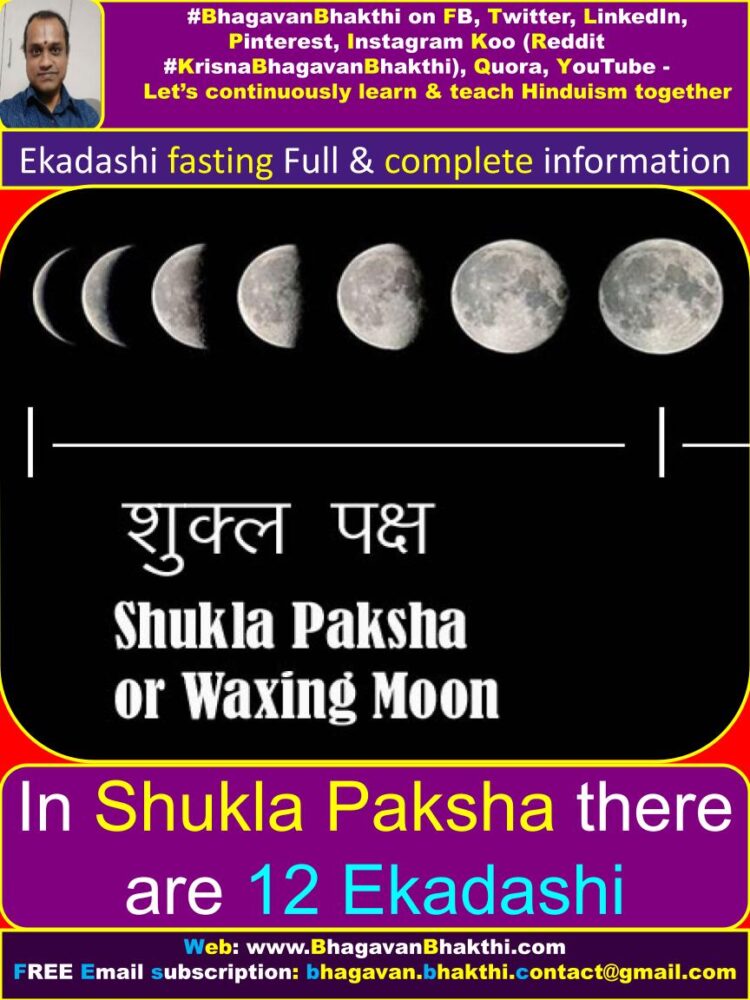
Ekadashi names during the Krishna Paksha as per Hindu Month Calendar (Panchanga) is as given below:
Chaitra Month : Paapavimochini Ekadashi (पापविमोचिनी एकादशी) (pāpavimōcinī ēkādaśi) (Falls on March – April) (Presiding deity Lord Sri Rama)
Vaishakha Month : Varoothini Ekadashi (वरूथिनी एकादशी) (varūthinī ēkādaśi) (Falls on April – May) (Presiding deity Lord Sri Madhusudana)
Jyeshtha Month : Aparaa Ekadashi (अपरा एकादशी) (aparā ēkādaśi) (Falls on May – June) (Presiding deity Lord Sri Trivikrama)
Ashada Month : Yogini Ekadashi (योगिनी एकादशी) (yōginī ēkādaśi) (Falls on June – July) (Presiding deity Lord Sri Vamana)
Shravana Month : Kaamikaa Ekadashi (कामिका एकादशी) (kāmikā ēkādaśi) (Falls on July – August) (Presiding deity Lord Sri Sridhara / Sridhar)
Bhadrapada Month : Annadaa Ekadashi (अन्नदा एकादशी (annadā ēkādaśi) (Falls on August – September) (Presiding deity Lord Sri Hrishikesha)
Ashveeja (Ashvin) Month : Indiraa Ekadashi (इन्दिरा एकादशी) (indirā ēkādaśi) (Falls on September – October) (Presiding deity Lord Sri Padmanabha)
Kartika Month : Ramaa Ekadashi (रमा एकादशी) (ramā ēkādaśi) (Falls on October – November) (Presiding deity Lord Sri Damodara)
Margashirshaa Month : Pavitra (Utpanna) Ekadashi [पवित्रा (उत्पन्न) एकादशी] [pavitrā (utpanna) ēkādaśi] (Falls on November – December) (Presiding deity Lord Sri Keshava)
Pushya (Paushya) Month : Saphalaa Ekadashi (सफला एकादशी) (saphalā ēkādaśi) (Falls on December – January) (Presiding deity Lord Sri Narayana)
Magha (Maagha) Month : Shat Tilaa Ekadashi (षट् तिल एकादशी) (ṣaṭ tila ēkādaśi) (Falls on January – February) (Presiding deity Lord Sri Madhava)
Phalguna Month : Vijayaa Ekadashi (विजया एकादशी) (vijayā ēkādaśi) (Falls on February – March) (Presiding deity Lord Sri Govinda)
Adhika Month : Padmini Vishuddha Ekadashi (पद्मिनी विशुद्ध एकादशी) (padmini viśud’dha ēkādaśi) (Falls on March – April) (Presiding deity Lord Sri Purushottama)

More information will be added to this on regular basis. Please visit this post after some time to get updated information.
To watch videos on #Hinduism #Sanskrit language, SUBSCRIBE to my YouTube channel from this below link:
#BhagavanBhakthi YouTube channel
Dear friends, if you need any clarifications about this post, kindly let me know, I will definitely try to answer all of them.
Also your one LIKE, one COMMENT, One Share, one SUBSCRIPTION is highly important.
This will help to know the quality of this content and also it will be helpful to know if any improvements is required for the content.
If you feel this content is useful to you and has helped you to improve your knowledge, kindly share this with your well-wishers.
Because “SHARING MEANS CARING”.
For receive FREE EMAIL SUBSCRIPTION about #BhagavanBhakthi, you can send an email to [email protected] from your email ID.
NAMASTE!
Sri Gurubhyo Namaha
Sri Krishnaaya Namaha
Sri Krishnaarpanamastu
Subscribe / Follow us Share in Social Media
which is gandhari ekadasi and bhoumi ekadasi
Thanks for your question and sorry for late reply as I was held up in some work.
There is nothing like Gandhari Ekadashi.
Gandhari once did the Ekadashi Vrat (fasting) on Dashami mixed Ekadashi, that is, which is completely against the rules of Ekadashi. If vidha Ekadashi (Dashami mixed) is there means, we need to do the Ekadashi fasting the next day, that is, on the Dwadashi day.
This is the right procedure.
Our Puranas says, since Gandhari did fasting on Vidha Ekadashi, she lost all her 100 children.
Bhoumi Ekadashi is a local name for Jaya Eakadashi. Places like Orissa use this name Bhoumi Ekadashi instead of Jaya Ekadashi.
Shubhamastu!
Hi..I’m from Mauritius.
Great to send me some mantras which I can use for my morning prayers..thank you
Namaste,
Thanks for reaching me.
Best mantra is “Sri Vishnu Sahasra Naama”. By chanting this divine mantra, you can fulfill all the wishes.
Shubhamastu!
I am sure this piece of writing has touched all the internet people, its really really nice article.